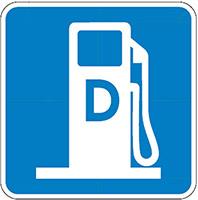Story by Brian Schmidt,
John Deere Power Systems
With fuel prices holding high, running a more fuel-efficient operation is now more important than ever. One of the best ways to keep your equipment running smooth and efficient is to pay attention to the fuel you put in them. Maintaining diesel fuel cleanliness and quality is a fundamental but critical way to ensure your equipment maintains peak efficiency and productivity.
Like all equipment, forestry machines are impacted by the type of diesel fuel used, such as ultra-low sulfur diesel (ULSD), but you also need to be diligent in maintaining fuel cleanliness and quality. Small particles of debris, excess water and the assorted byproducts formed as fuel ages can sabotage the efficient and productive operation of your machines.
First and foremost, quality and cleanliness must be addressed even before placing the nozzle in a machine’s tank. How and where fuel is stored—and the precautions observed when receiving bulk fuel, maintaining it in storage, and dispensing it from storage—are all critical issues to consider up front. Here are four tips for maintaining your fuel system’s cleanliness:
The Basics
The following on-vehicle maintenance tips are fundamental for ensuring the cleanliness of a machine’s fuel system:
—Replace fuel filters at proper intervals with filters meeting the manufacturer’s exact specifications.
—Drain the primary filter, which separates free water from the fuel, as often as required.
—Follow the manufacturer’s guidelines for periodically draining water from the fuel tank.
—Keep the tank’s debris screen in place.
—Regularly replace the fuel-tank breather.
—Use the proper grade of fuel for the ambient temperature.
Good Housekeeping
Practicing proper housekeeping is critical, specifically when fueling vehicles in the field from trailer-type tanks or from tanks in the back of other vehicles. In a forest setting, be sure to brush debris away before removing a machine’s fuel cap.
If portable tanks are used, mount them at an angle on your trailer or truck bed with a drain at the low end to eliminate water. It’s also good practice to keep the pump’s pickup out of the bottom quarter of the tank to avoid possibly drawing up water and debris. This is crucial as portable tanks are often rusty inside, have broken caps that are open to rain and debris, and have no filter between the tank and nozzle —all of which are typically the result of neglect.
Storage
If possible, keep reserve fuel stored inside to avoid temperature extremes that lead to condensation and thus additional free water in the fuel. Also, be sure to keep tanks out of direct sunlight, another preventative step against condensation and the microbial growth it can cuase.
Another storage tip is to stay away from galvanized tanks. Evidence indicates that diesel fuel reacts with zinc and zinc alloys to form unstable compounds that can deposit on working surfaces of an engine, causing rough running and low-power.
Check Fuel Quality
Check the quality and cleanliness of fuel when it’s delivered, since it was likely stored at the refinery, traveled the pipeline, stored at the terminal, then loaded into the delivery tanker—all potential sources of contamination. Need a simple way to check? Upon delivery of the fuel, place a sample in a clean white or clear container. The sample should be “clear and bright,” not cloudy with any trace of floating debris.
Lastly, machine owners should also double check the certificate of analysis for the fuel to ensure that it meets ASTM standards.
A final word of advice—when in doubt, be sure to regularly consult with the manufacturer of your equipment and engines to discuss fuel quality and cleanliness concerns.

